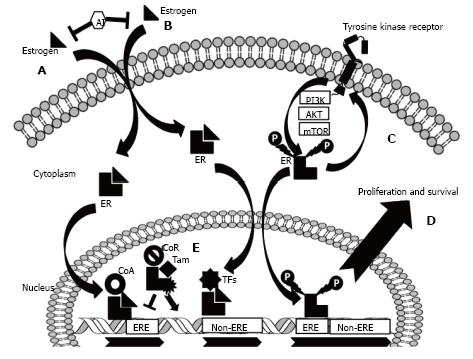Copyright
©2014 Baishideng Publishing Group Inc.
World J Clin Oncol. Dec 10, 2014; 5(5): 990-1001
Published online Dec 10, 2014. doi: 10.5306/wjco.v5.i5.990
Published online Dec 10, 2014. doi: 10.5306/wjco.v5.i5.990
Figure 1 The biology of the estrogen receptor and a schematic representation of the key mechanisms of endocrine resistance.
A: Estrogen induces gene regulation via the “classical” pathway. Estrogen passively diffuses through cell membranes and binds to the estrogen receptor (ER), inducing receptor dimerization. This complex recruits co-activators (CoA) and binds regions of DNA known as estrogen response elements (EREs), promoting transcription. Aromatase inhibitors (AIs) negatively regulate ER activity by reducing circulating estrogen levels; B: The ER can also cooperate with other transcription factors (TFs) and regulate the transcription of genes not harbouring EREs via the “non-classical” pathway; C: ER strictly interacts with receptor tyrosine kinases (RTKs) via their downstream effectors. ER can, in fact, be directly phosphorylated and activated, the final result being gene expression and a cascade of second intracellular effectors (the non-nuclear activity of ER); D: This strict and bi-directional crosstalk between ER and RTKs and downstream effectors is responsible for endocrine resistance; E: In breast cancer cells, SERMs [such as tamoxifen (Tam)] bind ER and induce the recruitment of co-repressors (CoR) that negatively regulate the activity of ER. Mutated forms of ER are able to enhance gene expression in spite of the presence of Tam.
- Citation: Milani A, Geuna E, Mittica G, Valabrega G. Overcoming endocrine resistance in metastatic breast cancer: Current evidence and future directions. World J Clin Oncol 2014; 5(5): 990-1001
- URL: https://www.wjgnet.com/2218-4333/full/v5/i5/990.htm
- DOI: https://dx.doi.org/10.5306/wjco.v5.i5.990









